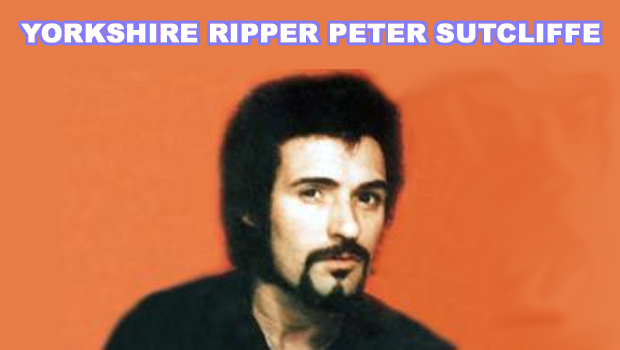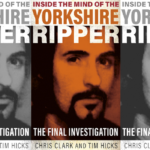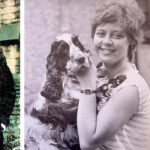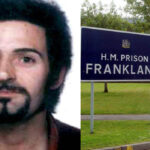The Ripper’s Lorry Murders #2
by TIM HICKS & CHRIS CLARK
~~~~~
Ilkley: Proof Positive
Until now, the conventional wisdom was that all of Sutcliffe’s attacks were launched from his car. Chris however was convinced that this was not so and conducted his research on the basis that Sutcliffe used his lorry on some of the murders.
In this article the authors have collated all the cases Chris has identified as committed from Sutcliffe’s lorry, not his car. They are shown as V5 in Column F “Vehicle Used” in Table 13 below.
The cases are not in chronological order for editorial reasons of space management and to group some cases by force area in each article. They are in six parts as follows:
- The Ripper’s Lorry Murders Part 1. Bedgebury Forest woman.
- The Ripper’s Lorry Murders Part 2. Ilkley: Proof Positive.
- The Ripper’s Lorry Murders Part 3. More ligature killings.
- The Ripper’s Lorry Murders Part 4. Leicester, Doncaster and Sheffield.
- The Ripper’s Lorry Murders Part 5. Bristol, London, Sussex and Essex.
- The Ripper’s Lorry Murders Part 6. “Hope”: More witnesses.
Table 13 – Victim list and vehicles used – here.
Here Chris gives the background and more information on the individual murders the authors believe were committed from Sutcliffe’s lorry:
Background: Sutcliffe’s access to lorries
“Sutcliffe then started employment as a lorry driver on the 29th of September of 1975 working for a Common Road Tyre Company, Okenshaw situated at the junction of the M62 Motorway and a spur off the M606 into Bradford; the work involved short and medium distance hauls all over the North and the Midlands. He used the experience to familiarise himself with the network of motorways and trunk roads linking its destinations to each other including the best access routes to many towns and city centres an art that he perfected from his already overall extensive knowledge that he had gained from socially driving around the North of England, the Midlands and London and Home Counties.
However after just over a fortnight’s employment on 15 October 1975 he was caught stealing second hand tyres and the police were informed. Sutcliffe was arrested and during the following year after entering a guilty plea at a later court hearing on 5 March 1976 he was fined and he was later sacked in that April for bad time keeping.
In October 1976 Sutcliffe finally found work as a lorry driver for T&WH Clark (Holdings Ltd) situated on the Canal Road Industrial Estate between Shipley and Bradford. They were a small engineering transport firm and working for them took him all over the country and involved a lot of overnight stops where he would use the bunk bed in the rear of the cabin and he was once on his own again with no one to account to and left to his own devices. He started proving himself over several months in one of the firm’s four and six ton big rigid Lorries and then onto a Ford Transcontinental which at £250,000 was the most expensive and advanced HGV vehicle in England at the time.
Sutcliffe clearly suffered from ‘little man syndrome’ as well as ‘obsessive compulsive disorder’ and enjoyed the height, mass and speed of the lorry; as well as spending hours cleaning and polishing both the inside and outside of the cabin whilst awaiting loading and unloading. This would have removed any forensic evidence from the cab.
At work Sutcliffe was one of Clark’s most conscientious drivers who kept immaculate logs and repair records. His workmates saw him as a loner who never showed any sign of violence did not swear or speak crudely about women although he christened his lorry ‘Wee Willie’ which was a source of amusement for them. Sutcliffe was well liked by his bosses and colleagues alike and was recognised to be brilliant at roping-and-sheeting large and often difficult loads. He was the person that everyone turned to when they got a delivery ticket for an unfamiliar town he had ‘A-Z’ street maps for every possible destination.
At Clark’s at the beginning of 1980, Sutcliffe must have felt he had got a really secure job even a job for life. The firm had been forced to sack all their drivers for alleged thefts from the loads but not him. He had been the one exception the one driver Chairman Tom Clark felt he could trust. Yet there were those at Clarks who had noticed Sutcliffe’s habit of occasionally turning up at work with false number plates on his car. A fact considered insignificant by his workmates, at least until the first weekend of 1981.
The management had been so impressed with Sutcliffe regarding him as possessing all the virtues required by the best lorry drivers that he was chosen to appear in a promotional brochure for the firm. In the following photograph he is shown hair in place, beard neatly trimmed as usual behind the wheel of ‘Wee Willie’ and a giant enlargement of the photograph was given pride of place in the entrance to the firm’s offices.”
Yvonne Mysliwiec (Case 57) (West Yorkshire Police)
The Mysliwiec attack is important because it establishes without doubt that Sutcliffe committed attacks when he was in his lorry. However, as we shall see, this vital information was missed by the West Yorkshire Police Ripper investigation.
It is clear that Sutcliffe used his lorry -not just his car- to commit murders. This verifies the authors belief that Sutcliffe’s offending was not just confined to West Yorkshire and Greater Manchester, but potentially covered every force area in the UK that Sutcliffe’s work as a lorry driver took him to, as shown in the lead illustration. That is, all over England and parts of Southern Scotland.
On Friday October 11 1979 Yvonne Mysliwiec a 21 year old reporter for the Ilkley Gazette who lived in the town and who also worked as a barmaid on Thursday nights survived an attack. She was attacked from behind after crossing a footbridge at the town’s railway station and suffered severe head injuries from a blunt instrument. Thankfully the attack was interrupted by a witness who described him as being in his 30’s dark swarthy with crinkly hair, who got into a lorry and drove off.
Sutcliffe was often mistaken for a coloured man at night because of his dark complexion and curly hair. As described by victims here at 6, 14 and 33 minutes, and a witness at 24 minutes, and as shown in the illustration above.
The witness was Brian Copping, then aged sixteen. Bryan has exclusively provided the NYE with this annotated photograph of the attack and his comments, in which he positively and explicitly identifies Peter Sutcliffe as the attacker. His story is told in the newspaper article below the photograph.

“Key: To the attack on Yvonne Mysliwiec by Peter Sutcliffe (AKA The Yorkshire Ripper) on Thursday the 11th of October 1979 at 20:55hrs in Ilkley, West Yorkshire.
ME: Bryan Copping talking to and passing Yvonne going up on steps of Footbridge at 20:54hrs
Yvonne: Yvonne talking to and passing Bryan coming down on steps of Footbridge at 20:54hrs
Sutcliffe: Yorkshire Ripper, Peter Sutcliffe 5 yards behind following Yvonne on Footbridge and where Bryan and Peter Sutcliffe make brief eye contact with each other and then pass each other on Footbridge at 20:55hrs
Yvonne Attacked Here: Yvonne at bottom of stone steps and entrance leading out onto Railway Road hidden and out of view by high stone walls and trees/bushes as Peter Sutcliffe makes his move and attacks Yvonne from behind hitting her on back of head/skull with hammer at 20:55hrs
ME At Time of Attack: Bryan Copping still on Footbridge when attack on Yvonne by Peter Sutcliffe takes place still walking towards Springs Lane exit of Footbridge and home Springs Terrace at 20:55hrs
SHOP: Darbyshire’s Off Licence/Shop on Railway Road, Ilkley, which Bryan Copping had just visited at around 20:52hrs”

Detective Superintendent John Stainthorpe led the investigation and can be heard in the documentary The Untold Story of the Yorkshire Ripper Peter Sutcliffe at 28 minutes stating plainly that he knew it was an attack by the Yorkshire Ripper and that senior officers on the ripper squad ignored this. As a result, crucially, they missed out on the fact that Yvonne Mysliwiec’s assailant was a lorry driver. Detective Superintendent Stainthorpe goes on to justfy this by asserting that West Yorkshire Police wanted to placate the public and not increase the pressure on West Yorkshire Police by admitting another attack by the Yorkshire Ripper.
Sutcliffe was never convicted of this attack. It remains officially unsolved. Although both an exceptionally good eye witness who had a good look at Yvonne’s assailant and the detective in charge of the case have both stated categorically that the crime was committed by Peter Sutcliffe.
Debra Schlesinger (Case 31) (West Yorkshire Police)
On Thursday the 21st of April 1977, Debra Schlesinger aged 18 years of Leeds was stabbed through the heart as she walked down the garden path of her home in Hawksworth Estate, Leeds after a night out with friends. After being stabbed fully clothed she ran and was chased until she collapsed and died in her doorway. Witnesses recall seeing a dark bearded man near the scene and with her reaching home the attacker was scared off before doing anything further with her body. At the time of this -murder West Yorkshire Police ruled out this case as being part of the Yorkshire Ripper series; however this case was included in the 22 unsolved attacks and murders that Chief Constable Keith Hellawell later investigated and put to Sutcliffe. Sutcliffe was delivering locally in his lorry at the time.
Carol Wilkinson (Case 38) (West Yorkshire Police)
On Monday the 10th of October 1977 at sometime between 9.00 and 9.30 am 20 year old Carol Wilkinson was savagely attacked as she walked from her home at 131 Ranelagh Avenue, on the Ravenscliffe Estate, Bradford down a lonely lane in a field off Woodhall Road, at the back of her place of work Bradford Bakery in Gain Lane, Fagley. She had used this route as a short cut because of a bus strike. A male hospital cook also taking the same short cut and who may have disturbed her attacker, found Carol lying in a pool of blood.
She was battered about the back of her head with what the police described as a large stone (walling hammer) and partially stripped her trousers and pants pulled down and her bra lifted up; it would appear that the offender had been disturbed during the attack and Carol was found lying face down (as in the case of Judith Roberts in 1972).
When found Carol was still barely alive and taken to hospital where she was found to have multiple skull fractures and severe brain damage and immediately put on a life support machine. Two days later on 12 October her doctors concluded that her brain had ceased to function and the life support machine was switched off.
Sutcliffe’s home was just over three miles from Bradford Bakery and his place of work was about two and-a-half miles from it. The route out would be a regular one for Sutcliffe doing his deliveries in his lorry if travelling to Hull, Sunderland or Scarborough.
We will leave the last word to West Yorkshire Police:
Appeal for Information
“The murders of Carol Wilkinson, Debra Schlesinger and an assault on a victim in Ikley in 1979, in which the victim [Yvonne Mysliwiec*] was seriously injured but survived, remain unsolved and subject to review by the force’s Major Investigation Review Team.
West Yorkshire Police continues to review and where possible reinvestigate all unresolved homicides and serious crimes to bring offenders to justice and to bring much needed closure to the victims and their families.
Any information relating to unsolved investigations can be passed to the Major Investigation Review Team on 101.”
*Authors annotation













